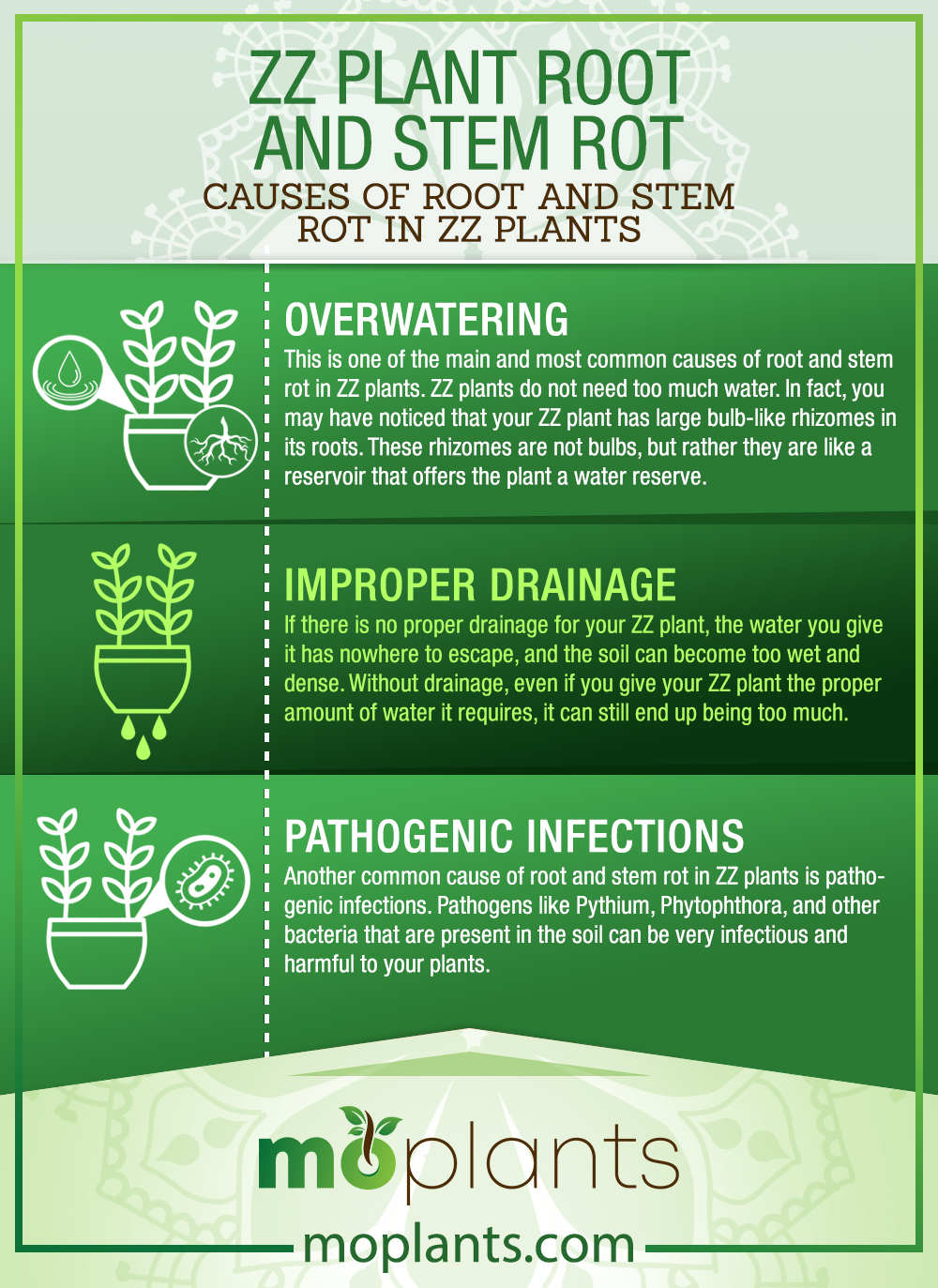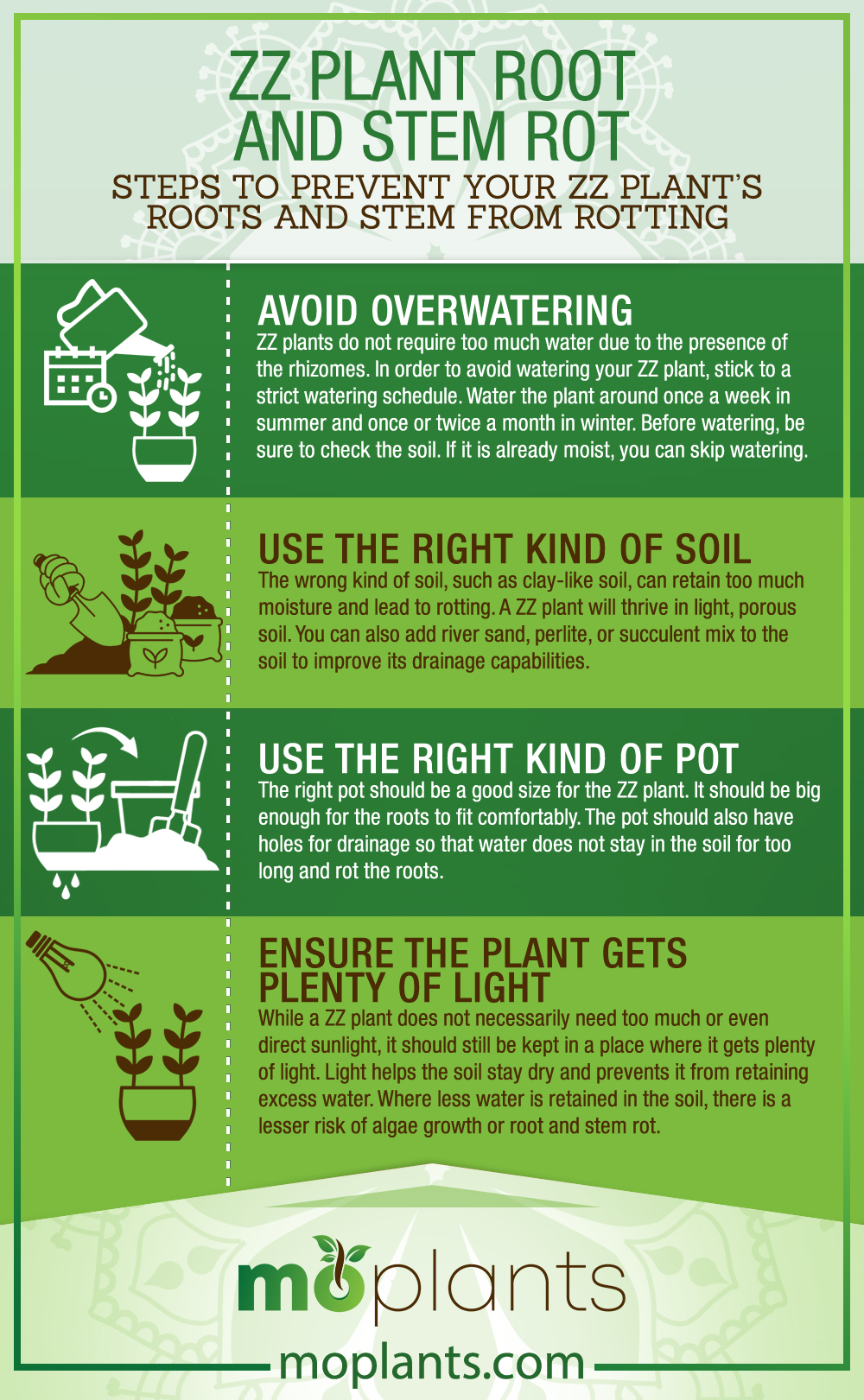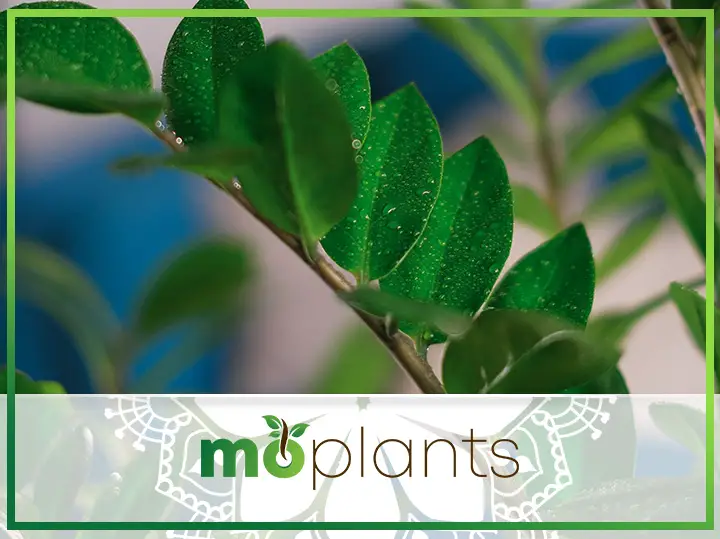ZZ plants, or Zamiifolia Zamioculcas, as they are officially called, can be wonderful plants to keep indoors. They have a unique and beautiful appearance that sets them apart from any other house plant, and they are also very versatile and hardy. With a relatively easy care routine, you can rest assured that your ZZ plant will flourish in your home. Whether you keep it near a sunny window or in a small room with very little sunlight, the ZZ plant will survive and thrive!
But something that many people do not realize is that ZZ plants have a silent killer: root and stem rot! Root rot happens slowly and under the surface of the plant’s soil, so you often don’t realize it’s happening until it might be too late. If the rot travels all the way up to the stem of the plant, then you know you need to take quick and urgent action to save the plant.
If you’re fond of your ZZ plant and want to ensure that it stays healthy and happy in your home, you should be aware of the causes of root and stem rot in ZZ plants, how to tell if your ZZ plant might be suffering from rot, how to fix that plant, and what you can do in the future to prevent the plant from rotting.
Causes of Root and Stem Rot in ZZ Plants
ZZ plants, like any other plants, need three main things to survive: water, oxygen, and light. Your plant can run into trouble when either of these three things is present in overabundance. The main cause of root and stem rot in ZZ plants has to do with the amount of water it receives, which in turn affects the amount of oxygen it is able to absorb.
Here are the main causes of root and stem rot that you should be aware of:
Overwatering
This is one of the main and most common causes of root and stem rot in ZZ plants. ZZ plants do not need too much water. In fact, you may have noticed that your ZZ plant has large bulb-like rhizomes in its roots. These rhizomes are not bulbs, but rather they are like a reservoir that offers the plant a water reserve. Due to the presence of the rhizomes, you do not need to water your ZZ plant too much or too often. Many people do not realize this and overwater their ZZ, leading to root and stem rot.
Improper Drainage
If there is no proper drainage for your ZZ plant, the water you give it has nowhere to escape, and the soil can become too wet and dense. Without drainage, even if you give your ZZ plant the proper amount of water it requires, it can still end up being too much. A pot with no drainage hole at the bottom is unsuitable and can result in root and stem rot.
Pathogenic Infections
Another common cause of root and stem rot in ZZ plants is pathogenic infections. Pathogens like Pythium, Phytophthora, and other bacteria that are present in the soil can be very infectious and harmful to your plants.
Infographic

How to Tell If Your ZZ Plant’s Roots or Stems Are Rotting
If you know the signs of root and stem rot in ZZ plants, you can spot the problem and fix it before your plant reaches the point of no return. For stem rot, since the problem is in the stem itself and not hidden below the soil, it is pretty easy to spot.
The stems can become drooping and unable to support the weight of the plant. In worse cases, the stem might become discolored – a dark brown or black color – near the soil. If the stems have started to rot, this is a sign that the roots are probably rotting quite a bit and that the plant needs to be urgently tended to.
As for root rot, it is not as easy to spot, and you have to look out for other signs that might indicate rotting roots. One of these signs is drooping or discolored stems, as we mentioned above. Another clear sign of rotting roots is smelly soil or soil that is growing algae near the plant. The musty smell and algae are a result of overwatering. If you think your ZZ plant might have been overwatered, then there are high chances of root rot.
Additionally, you can look at the ZZ plant’s roots to get an idea of its health. Healthy ZZ roots are white in color, and they have a dry, almost crisp texture. If you find that the color of the roots has changed to brown or black or that the texture is soft and mushy, the roots are probably rotting.
How to Fix A ZZ Plant with Rotten Roots
Once you’re reasonably certain that your ZZ plant is suffering from root rot, you need to fix it in order to prevent the plant from dying. To begin with, you’ll need to remove the plant from its container. It is important to be careful doing this so that you do not damage the plant. The best way would be to overturn the pot or container the plant is in until the plant and all of the soil slide out.
Next, take your ZZ plant over to the sink and rinse off the roots with room temperature water, removing any of the soil stuck to them. Then, you can grab a pair of gardening scissors or a knife and cut off any of the rotted roots.
Be careful to make clear and clean cuts while you do this. Make sure to remove all of the roots that are affected by the rot, including any rhizomes that might appear brown or mushy. If you accidentally leave any rotted root, the rot can continue to spread, making the entire process useless. You can also trim off any damaged foliage while you’re at it, including drooping stems and brown or yellowed leaves.
Once you’ve cut off all the rotten roots and rhizomes, you can repot your ZZ plant. However, you shouldn’t use the same soil as before, as that soil is likely too wet or full of rotten plant material, bacteria, pathogens, and algae. Instead, plant your ZZ in fresh, porous soil. You should also make sure that the pot you choose has drainage holes at the bottom.
Before repotting, you can also apply fungicide to the roots if you think your plant might suffer from some pathogenic infection. While doing this, be sure to follow the instructions for the fungicide to avoid causing more damage to your plant.
Finally, when your ZZ plant has been repotted, it is time to water it lightly. Remember, overwatering was probably the cause of the whole mess, so be careful to give the plant just a little bit of water. Add enough water till the soil is lightly damp, and then give your ZZ some time to rest and de-stress. Your ZZ plant should be as good as new by the next morning!
How to Fix A ZZ Plant with Rotten Stem
If your ZZ plant has visibly rotten stems, then chances are that the roots are also rotten and are likely too far gone. The ZZ plant can only be saved in such a case through propagation. When it comes to ZZ plants, you can propagate both the stems and the leaves.
To propagate ZZ stems, you first need to cut off all the healthy stems from the plant, leaving behind the rotten ones. Make sure you use clean and sharp scissors. Then, place the stems in a glass container that is filled halfway with water. The water should cover at least half of the stems. Place the container somewhere with plenty of sunlight and fresh air. You have to change this water out for fresh water every three to four weeks and keep an eye out for mold. After a few weeks, you’ll notice new roots growing out of the bottom of the stems. Then, you’ll also see rhizomes begin to grow. Once you have rhizomes growing, you can take the stems out of the glass container and put them into a new pot.
If you find that most of the stems from your plant have rotted, you can try propagating just the leaves of the healthier stems. To do this, you must pick and remove a few healthy leaves. They should be visibly healthy, crisp, and have a bright green color.
Set them aside in a cool, dry place for a couple of hours and prepare a pot with moist soil in the meantime. Then, you can insert your leaves into the soil so that the base and stems of the leaves are a few inches deep in the soil. Keep the pot in a place with sunlight and fresh air, and water the leaves every few days. The leaves will grow small roots and rhizomes at the bottom in a month. There is no need to repot the leaves if the pot is large enough to allow a new plant to begin growing.
Steps to Prevent Your ZZ Plant’s Roots and Stem from Rotting
Root and stem rot in a ZZ plant can be a serious problem and, if left untreated, can cause the whole plant to die. While we’ve gone over what you should do to fix a ZZ plant that has suffered from root or stem rot, it would be much preferred if you could prevent the plant from rotting in the first place!
Here are some steps you can follow to prevent your ZZ plant’s roots and stems from rotting:
Avoid Overwatering
ZZ plants do not require too much water due to the presence of the rhizomes. In order to avoid watering your ZZ plant, stick to a strict watering schedule. Water the plant around once a week in summer and once or twice a month in winter. Before watering, be sure to check the soil. If it is already moist, you can skip watering.
Use The Right Kind of Soil
The wrong kind of soil, such as clay-like soil, can retain too much moisture and lead to rotting. A ZZ plant will thrive in light, porous soil. You can also add river sand, perlite, or succulent mix to the soil to improve its drainage capabilities.
Use The Right Kind of Pot
The right pot should be a good size for the ZZ plant. It should be big enough for the roots to fit comfortably. The pot should also have holes for drainage so that water does not stay in the soil for too long and rot the roots.
Ensure The Plant Gets Plenty of Light
While a ZZ plant does not necessarily need too much or even direct sunlight, it should still be kept in a place where it gets plenty of light. Light helps the soil stay dry and prevents it from retaining excess water. Where less water is retained in the soil, there is a lesser risk of algae growth or root and stem rot.
Infographic

The Bottom Line
ZZ plants are a wonderful addition to any home. They are beautiful, hearty plants that are, for the most part, easy to care for and maintain. One of the main problems people run into when it comes to keeping ZZ plants is the roots and stems rotting. But don’t worry because, with everything we have discussed above, you’ll know exactly what to do if you think your ZZ plant might be suffering from root or stem rot. Remember, the best way to keep your ZZ plant healthy is by watering it appropriately and avoiding overwatering.

